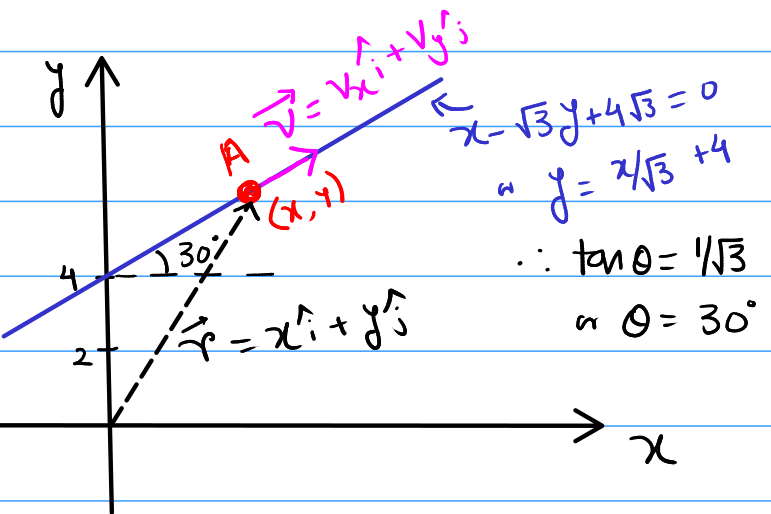Try out this problem on the concept of Angular momentum from National Standard Examination in Physics 2015-2016.
A particle of mass 10g starts from rest at $t=0$s from point (0m, 4m) and gets accelerated at $0.5m/ s^2$ along $x-\sqrt{3}y + 4\sqrt{3}=0$ in XY plane. The angular momentum of the particle about the origin (in SI units) at $t=2$s is
(a) $-0.01\sqrt{3} \hat{k}$
(b) $-0.02\sqrt{3}\hat{k}$
(c) Zero
(d) $-20\sqrt{3}\hat{k}$
Circular Motion
Center of Curvature for generalised motion
Vector and their Components
Concept of Physics H.C. Verma
University Physics by H. D. Young and R.A. Freedman
Fundamental of Physics D. Halliday, J. Walker and R. Resnick
National Standard Examination in Physics(NSEP) 2015-2016
Option-(b) $-0.02\sqrt{3}\hat{k}$
The first thing to remember is that Even if a particle is not moving in a circle, then also it can have circular motion, i.e., Angular Momentum, Torque, Centripetal forces can exist.
This is the case because any random curves can be approximated bu circles. Even straight lines are circles with radius $\to \infty$.
You can use the circle's centre as the centre of rotation or you can also use the origin. Using the origin is often easier as the positions can be directly given using position vectors.


In our problem, The motion is happening on the line $y = \frac{x}{\sqrt{3}}+4$.
If at any moment of time it's velocity along the curve is $\vec{v}=v_x \hat{i}+v_y \hat{j}$ and it's position vector is $\vec{r}=x \hat{i}+y \hat{j}$ then, It's angular momentum ($\vec{L}$) with respect to origin can be given by,
$$\vec{L} = m(\vec{v}\times \vec{r}) $$
where m is the mass of the particle.
From the previous image, if $(x,y)$ is then they must satisfy $y = \frac{x}{\sqrt{3}}+4$. Differentiating with respect to time,
$$\frac{dy}{dt} = \frac{1}{\sqrt{3}}\frac{dx}{dt} \to v_y = \frac{v_x}{\sqrt{3}}$$
Again differentiating w.r.t time,
$$a_y = \frac{a_x}{\sqrt{3}}$$ where $\vec{a} = a_x\hat{i}+a_y\hat{j}$ is the acceleration (we will not need this but I think it should be written here as we can also use this in solution).
Now at $t=0$, $v_x=0$. Hence, at $t=2s$, $v_x $=$ a_xt $= $a\cos(30^{\circ})t $= $0.5\frac{\sqrt{3}}{2} 2 $= $\frac{\sqrt{3}}{2}$
Now, $x$ = $v_x(t=0 )t+\frac{1}{2}a_x t^2$ = $0 + \frac{1}{2}a\cos(30^{\circ})2^2$ = $\frac{\sqrt{3}}{2} $
Then, $v_y = \frac{v_x}{\sqrt{3}}= \frac{1}{2}$ and $y = \frac{x}{\sqrt{3}} + 4 = \frac{1}{2} + 4 = \frac{9}{2}$.
Hence, $\vec{r}$ = $\frac{\sqrt{3}}{2}\hat{i} + \frac{9}{2}\hat{j}$ and $\vec{v}$ = $\frac{\sqrt{3}}{2}\hat{i} + \frac{1}{2}\hat{j}$.
$\vec{L}$=$m(\vec{r} \times \vec{v})$=$-m 2 \sqrt{3} \hat{k}$=$-\left(\frac{10}{1000}\right) 2 \sqrt{3} \hat{k}$=$-0.02 \sqrt{3} \hat{k}$
Note: The answer is asked in S.I unit. So, m = 10g = $\frac{10}{1000}$kg = 0.01.
Physics Olympiad Program at Cheenta